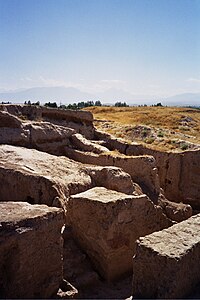Panjakent
Panjakent | |
|---|---|
 Pajakent Bazaar | |
| Country | |
| Province | Sughd |
| Population (2000) | |
| • Total | 33,000 |

Panjakent (Template:TaPA:Панҷакент/پنجکنت) also spelled Panjikent or Panjekent, Пенджикент in Russian, is a city in the Sughd province of Tajikistan on the Zeravshan river - population 33,000 (2000 census). It was once an ancient town in Sogdiana. The ruins of the old town are on the outskirts of the modern city.
History
Ancient Panjekent was a small but flourishing town of the Soghdians, in pre-Islamic Central Asia and served as the capital of Panch and was known as Panchekanth. [1]
The ethnic and territorial name "Soghd/Soghdian" ur Sughd/Sughdian occurs is mentioned in history as early as the Iranian Achaemenid Dynasty (6th century B.C.). The Achaemenid's founded several city-states, as well as cities along the ancient Silk road route and in the Zarafshan valley.
The town grew in the 5th century A.D. and many professionals such as established businessmen and landowners made their livelihoods in the Panjakent. In A.D. 722, Arabian forces besieged and annexed the town. The last ruler of the town Devashtich fled into upper Zarafshan but he was captured and sentenced to death. For around 50 years, ancient Panjikent was ruled by new administrators but towards the end of the 8th century the town on the upper terraces was depopulated and relocated. Many ancient ruins of the old city, particularly the city architecture and works of art remain today.
According to Arab geographers, Panjikant in the 10th century had a formal Friday mosque that distinguished the place as a town from a village. It was the easternmost city of Soghd, and became well known for its walnuts. [2]
Russian archaeologist Boris Marshak spent more than fifty years excavating the ruins at Panjakent. [3]He remained there even after Tajik independence as director of the excavation of the Panjakent ruins, even during the years of Civil War in Tajikistan from 1992-1997. Through close cooperation with the government of Tajikistan Marshak ensured the protection and continued excavation of the Panjakent ruins.
References
- ^ Gorgâni, Tirdâd. "Welcome to Penjakent". GEOCITIES. Retrieved July 23.
{{cite web}}: Check date values in:|accessdate=(help); Unknown parameter|accessyear=ignored (|access-date=suggested) (help) - ^ Marshak, B.I. "Panjikant". Encyclopedia Iranica . Retrieved July 23.
{{cite web}}: Check date values in:|accessdate=(help); Unknown parameter|accessyear=ignored (|access-date=suggested) (help) - ^ Shkoda, V. (October 2003). "Marshak's Bibliography and CV". Transoxiana Webfestschrift Series I. Transoxiana: Journal Libre de Estudios Orientales. Retrieved 2006-10-14.
External links
- Marshak. B.I. "Panjikant" in Encyclopedia Iranica [1]
